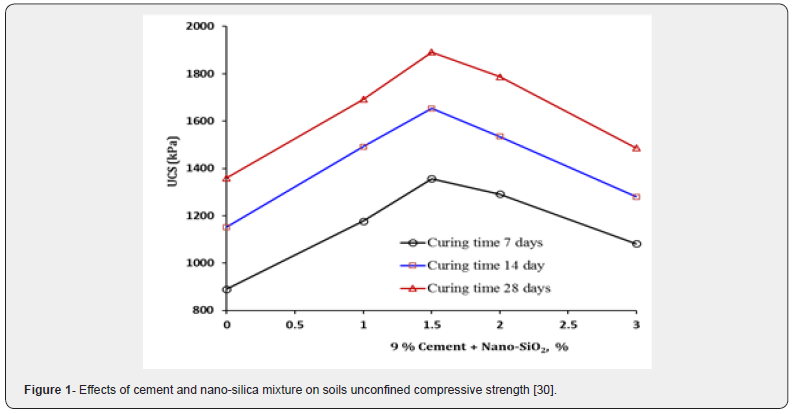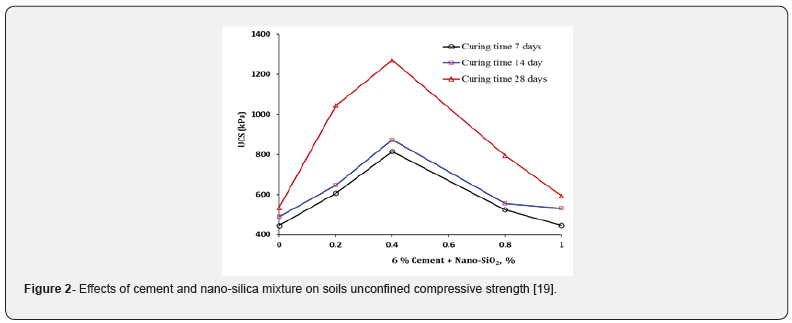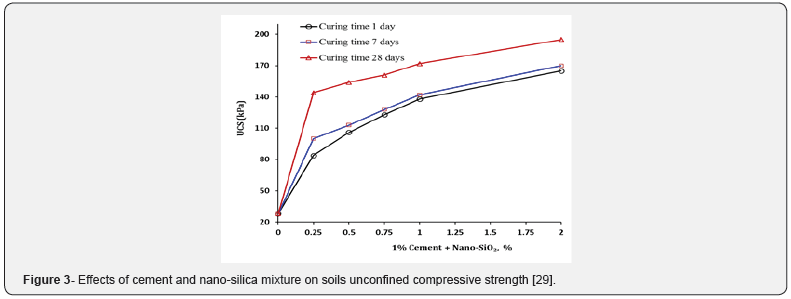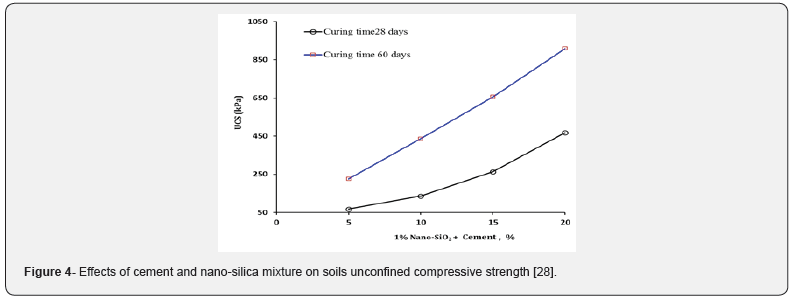Assessing the geotechnical properties of soils treated with cement and nano-Silica additives
Dario Furnari*1,2, Nadya Khan3, Melissa Delaney1, Khaled Hamlaoui1, Sebastien Lagree1,2, Amy Peace1,2, Susana Sanchez1, Aliaksandra Eyring1, Elena Talyanova1, Monika Milczarek4 and Sergey Petrov5
1Department of Biomedical Sciences, UK
2Department of Lagree Studio, USA
3Department of Pharmacology, College of Medicine and Health Sciences, UAEU
4Department Monroe Medical, UK
5Department Ltus Academy, Ukraine
Submission: November 11, 2020; Published: November 23, 2020
*Corresponding author: Dario Furnari, Department of Biomedical Sciences, UK, Germany, Netherlands, USA, Department of Lagree Studio, USA
How to cite this article: Dario F, Nadya K, Melissa D, Khaled H, Sebastien L, et al. Brain and Touch Therapy: Research On Massage Therapy, Fitness, Rehabilitation – Review Article for a Randomized Controlled Trial. JOJ scin. 2020; 2(3): 555587. DOI: 10.19080/JOJS.2020.02.555587
Abstract
One of the problematic soil types is fine-grained soils including CL, CH, ML, MH, which are found in construction projects in large amounts. The main problem with these soils in construction projects is their high ductility (inflation and shrinkage) and low strength, so the presence of these soils in the foundation of construction projects will cause hazards, indicating the necessity of utilization of improving methods. Studies conducted on geotechnical engineering effects of nanomaterials show the efficiency of these materials for soil treatment. by adding nanomaterials to the soil treated with cement, the strength of the base soil has been increased and the percentage of cement use has been significantly decreased, reducing the CO2 emissions into the environment, hence reducing the environmental pollution. The increase in soil strength is due to the high specific surface area of nanomaterials and cationic interactions with soil compounds. Research on nanomaterials and fine-grained soil treatment is very promising increasing our understanding of the relationship between nanotechnology and geotechnical engineering. In this research, the effects of nano-silica on the uniaxial compressive strength of fine-grained soils are investigated.
Keywords:Stabilization, Fine-grained soil, Nanotechnology, Uniaxial strength, Nano-silica
Introduction
Fine-grained soils CL, CH, ML, MH are considered as problematic soils present in almost every civil project, especially in roadbeds. Most of these soils are considered as inflatable soils [1-3]. Due to their water absorption ability, in addition to volume changes (so-called swelling), their strength is also significantly reduced, intensifying risks in the foundation of construction projects as well as in the road pavement beds. Therefore, various physical and chemical methods have been used to stabilize this type of soil. The advantages of using nanomaterials can be expressed in reducing environmental damages and gaining the desired strength for the problematic soils [1,4,5].
Additives used previously include lime, cement, bitumen, coal fly ash, etc. One of the basic requirements in construction projects is minimizing the environmental damages by choosing the most proper material, in addition to reducing project costs. Sometimes the land to be recovered covers a wide area such as highways, railways, dams, airports, etc so to overcome the requirements of the designs and to reduce environmental pollution, nano-products can be used as additives to problematic soils [1,6].
Various studies such as Kalkan et. al. [7,8], Taha [9,10], Taha and Taha [5], Arabani et.al [11], Mohammadi and Niazian [12], Changizi and Haddad [13-15] and Choobbasti et al. [16] have shown that the addition of small amounts of nanomaterials to the fine-grained problematic soils increases their strength significantly and minimizes soil swelling. The advantage of adding nanomaterials in comparison to other stabilizing materials such as lime and cement is that the small amount of nanomaterials can result in obtaining similar outcomes, presented in studies like Sobolev et al [17], Bahmani et al. [18,19], Choobbasti et.al [20,21], Choobbasti et al. [22]0.4, 0.8 and 1.2% by weight of the soil, Tsampali et al. [23] and Yao et al [24].
Nanotechnology
Nanotechnology is the manipulation of matter on an atomic, molecular, and supramolecular scale. A more generalized description of nanotechnology is defined as the manipulation of matter with at least one dimension sized from 1 to 100 nanometers. Nanotechnology in a simple definition allows the production of new materials or systems by considering the control of molecular and atomic levels, the controlled arrangement of nanostructures, and the achieving unique properties in the final system. This technology due to its rapid development and proper performance in various fields and the limitations in traditional materials (including bitumen, lime, cement, etc.) has become of great importance for improving soil engineering parameters by introducing the nanomaterials [25,26].
Utilizing the properties of materials at the nanoscale has become very promising in human life. The development of industry and urban planning on one hand and the importance of environmental sustainability on the other hand have challenged soil researchers to find a satisfactory solution for improving the soil engineering properties rather than using existing traditional materials such as cement and chemical mortar (sodium silicate, acrylate, and epoxy). These materials were both expensive and environmentally damaging, so their use has been limited. Therefore, by limited utilization of these materials, other substances with better performance and reduced consequences have been introduced by nanotechnology [27].
Stabilization theory with nanomaterials
The application of nanomaterials for problematic soils is one of the chemical stabilization methods of soils. The nanoparticles with unique characteristics like possessing very small size, high specific surface area, surface charges, and nanoporous can actively react with other soil particles. As a result, their usage even in small amounts in soil modifies soil engineering properties. Various nanomaterials are used for soil-improving purposes, including nano-silica, nano-alumina, nano-clay, nano-carbon, and nanoiron. In this research, the effects of nano-silica in fine-grained soil improvement are briefly discussed.
Effects of nano-silica on improving soil strength
The uniaxial compressive strength test is commonly performed for stabilized soils. Figure 1 shows the effects of a mixture of treated soil with cement and different percentages of nano-silica at 7, 14, and 28 days of curing time. The results indicate that the strength increases with more curing time and cement hydration process completion up to 28 days. Also, with the addition of nanosilica by 1.5% of soil dry weight to the cement-treated soil uniaxial compressive strength increases, it can be inferred that Nanosilica has made the cement-stabilized soil structure denser and more cohesive due to its high specific surface area, fine particles, and cation exchange. With the addition of more nano-silica, the soil strength decreases, which may be due to the agglomeration of nanomaterial particles where the soil particles are separated from each other and the cohesion and integrity of soil particles are reduced so the uniaxial strength of the soil is reduced. results of Bahmani et al., [18], Lei Lang et al., [28] and Thomas and Rangaswamy [29] works, presented in Figures 2 to 4, also confirm this.

Results
i. The addition of small amounts of nanomaterials to the fine-grained soil has significantly increased the strength of the samples. The difference between adding nanomaterials and other stabilizing materials such as lime, cement, etc. in obtaining similar results is on the small amount needed for nanomaterial in comparison to other stabilizers.
ii. As the curing time increases, the uniaxial compressive strength of the stabilized samples increases, since the soil reacts with the nanomaterials synthetically as time goes on the reactions are more complete and samples are better stabilized.
iii. Addition of nanomaterials to cement-treated soils has reduced the percentage of cement use, resulting in reduced environmental pollution.



References
- FG Bell (2013)Hsein Juang, Dr. Vicki Moon, Dr. Janusz Wasowski (Eds.) Engineering geology and geotechnics, Elsevier.
- AAFiroozi, AA Firoozi, MS Baghini (2016) A Review of Clayey Soils. Asian J. Appl. Sci. 4(6): 1319-1330.
- AA Firoozi, C Guney Olgun, AA Firoozi, MS Baghini (2017) Fundamentals of soil stabilization. Int. J. Geo-Engineering 8(26): 1-16.
- BM Das (2016) Principles of Foundation Engineering, Global Engineering. Timothy L, Anderson Senior.
- MR Taha, OME Taha (2012) Influence of nano-material on the expansive and shrinkage soil behavior. J. Nanoparticle Res. 14.
- HAfrin (2017) A Review on Different Types Soil Stabilization Techniques. Int. J. Transp. Eng. Technol. 3(2): 19-24.
- E Kalkan, S Akbulut (2004) The positive effects of silica fume on the permeability, swelling pressure and compressive strength of natural clay liners. Eng. Geol. 73(1-2): 145-156.
- E Kalkan (2009) Effects of silica fume on the geotechnical properties of fine-grained soils exposed to freeze and thaw. Cold Reg. Sci. Technol. 58 (3): 130-135.
- MRTaha (2009) Geotechnical Properties of Soil-Ball Milled Soil Mixtures. Nanotechnol. Constr. 377-382.
- MR Taha, JMA Alsharef, RA AlMansob, TA Khan (2018) Effects of nano-carbon reinforcement on the swelling and shrinkage behaviour of soil. Sains Malaysiana 47(1): 195-205.
- M Arabani, AK Haghi, SA Mohammadzade, N Kamboozia (2012) Use of Nanoclay for Improvement the Microstructure and Mechanical Properties of Soil.In: Proc. 4th Int. Conf. Nanostructures pp. 1552-1554.
- M Mohammadi, M Niazian (2013) Investigation of Nano-clay effect on geotechnical properties of rasht clay, Int. J. Adv. Sci. Tech. Res. 3(3): 37-46.
- FChangizi, A Haddad (2015) Strength properties of soft clay treated with mixture of nano-SiO2 and recycled polyester fiber. J. Rock Mech. Geotech. Eng. 7(4): 367-378.
- F Changizi, A Haddad (2016) Effect of Nano-SiO2 on the Geotechnical Properties of Cohesive Soil. Geotech. Geol. Eng. 34(2): 725-733.
- F Changizi, A Haddad (2017) Improving the geotechnical properties of soft clay with nano-silica particles. Proc. Inst. Civ. Eng. - Gr. Improv. 170(2): 62-71.
- N Ghasabkolaei, A Janalizadeh Choobbasti, N Roshan, SE Ghasemi (2017) Geotechnical properties of the soils modified with nanomaterials: A comprehensive review. Arch. Civ. Mech. Eng. 17(3): 639-650.
- KSobolev, I Flores, LM TorresMartinez, PL Valdez, E Zarazua, et al., (2009) Engineering of SiO2 Nanoparticles for Optimal Performance in Nano Cement-Based Materials. Nanotechnol. Constr. 3: 139-148.
- SH Bahmani, BBK Huat, A Asadi, N Farzadnia (2014) Stabilization of residual soil using SiO2 nanoparticles and cement. Constr. Build. Mater. 64: 350-359.
- SH Bahmani, N Farzadnia, A Asadi, BBK Huat (2016) The effect of size and replacement content of nanosilica on strength development of cement treated residual soil. Constr. Build. Mater. 118: 294-306.
- AJ Choobbasti, SS Kutanaei (2017) Microstructure characteristics of cement-stabilized sandy soil using nanosilica. J. Rock Mech. Geotech. Eng. 9(5): 981-988.
- AJ Choobbasti, A Vafaei, SS Kutanaei (2015) Mechanical properties of sandy soil improved with cement and nanosilica. Open Eng. 5: 111-116.
- AJ Choobbasti, MA Samakoosh, SS Kutanaei (2019) Mechanical properties soil stabilized with nano calcium carbonate and reinforced with carpet waste fibers. Constr. Build. Mater. 211: 1094-1104.
- E Tsampali, EC Tsardaka, E Pavlidou, KM Paraskevopoulos, M Stefanidou (2019) Comparative study of the properties of cement pastes modified with nano-silica and Nano-Alumina. Solid State Phenom. 286: 133-144.
- K Yao, D An, W Wang, N Li, C Zhang, A Zhou (2020) Effect of nano-MgO on mechanical performance of cement stabilized silty clay. Mar. Georesources Geotechnol. 38: 250-255.
- HN Rafsanjani, M Kadivar (2011) Application of nanotechnology in civil engineering. Adv. Mater. Res. 261–263.
- F Nima, AAA Abang, D Ramazan (2012) Development of nanotechnology in high performance concrete. Adv. Mater. Res. 364: 115-118.
- Y Huang, L Wang (2016) Experimental studies on nanomaterials for soil improvement: a review. Environ. Earth Sci. 75.
- L Lang, N Liu, B Chen (2020) Strength development of solidified dredged sludge containing humic acid with cement, lime and nano-SiO2. Constr. Build. Mater. 230: 116-971.
- G Thomas, K Rangaswamy (2020) Strengthening of cement blended soft clay with nano-silica particles. Geomech. Eng. 20: 505-516.
- N Ghasabkolaei, A Janalizadeh, M Jahanshahi, N Roshan, SE Ghasemi (2016) Physical and geotechnical properties of cement-treated clayey soil using silica nanoparticles: An experimental study. Eur. Phys. J. Plus. 131: 134.






























